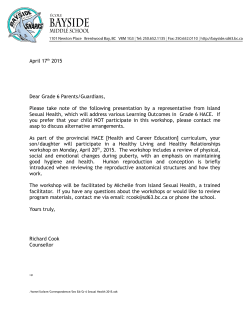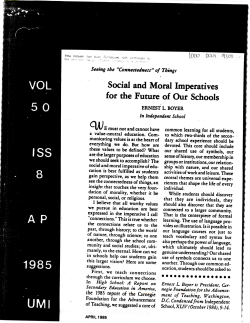
A Review of Ellen K. Feder. Making Sense of Intersex: Changing
GENDER STUDIES IN REVIEW A Review of Ellen K. Feder. Making Sense of Intersex: Changing Ethical Perspectives in Biomedicine. Bloomington: Indiana University Press, 2014. $28.00. Matthew Arbo | Assistant Professor of Biblical and Theological Studies Oklahoma Baptist University Shawnee, Oklahoma S uppose a male competitor in the upcoming summer Olympics in Rio de Janeiro perceived himself as female and wished to qualify for the women’s decathlon rather than the men’s. Virtually everything about this individual’s physical appearance is masculine, save the complicating fact that this individual sees himself as female. Observers might feel this strategy would give the competitor obvious athletic advantages over other women in the field. In fact, even if the International Olympic Committee allowed such gender re-qualification, it is likely that the international community would remain deeply skeptical, if not vehemently opposed to the idea. Although fictitious, it is not outside the realm of possibility to see a transgender competitor participating with official approval in another gender’s Olympic event at some point in the near future. Consider now a different, more complex case. At a new community book group, you are introduced to an earnest young man during coffee break named David. You notice from day one that David is a judicious reader. His comments to the group are circumspect and, on the whole, illuminating. You and David naturally befriend one another, meeting for lunch from time to time, sitting beside one another at book group; you even invite him along to church. With terrifying vulnerability, David confides in you one day that he was born intersex. And in admitting this to you he sees in your face that you haven’t the faintest idea what he’s talking about, though you sense intuitively that his admission will change the nature of your relationship fundamentally. He doesn’t blame you for your surprise—no one he tells has really ever heard of the condition. He then tells you his difficult condition once went by another name—“hermaphroditism”—if that helps. According to the Intersex Society of North America, “intersex” applies to “a variety of conditions in which a person is born with a reproductive or sexual anatomy that doesn’t seem to fit the typical 66 GENDER STUDIES IN REVIEW definitions of female or male.”1 That is the broad definition. More specifically, it refers to individuals born with both male and female reproductive organs, or individuals with “ambiguous” sexual anatomy. These sexual abnormalities can also appear to a lesser or greater degree; in other words, an intersex person can be “more” male than female or “more” female than male. To put it yet another way, intersex persons with significant anatomical ambiguity do not appear either male or female, but both male and female. Obviously this presents a special biological case deserving patient, scrupulous moral interrogation. HOW DO WE MAKE SENSE OF INTERSEX? In her new book, Making Sense of Intersex, philosopher Ellen Feder offers her own account of what it means to be intersex and how, morally, it should be treated by families and physicians. It isn’t often one can say with sincerity that a book is truly groundbreaking, but given the absence of substantive ethical treatment of this particular biomedical subject, Feder’s book actually does just that. Now, the question for our purposes is what kind of soil the breaking turns over. Admittedly, some of the soil offers fertile ground for further moral reflection, as when the author narrates first-hand testimonies of those who were themselves born intersex. In other places, the soil is simply too stale or polluted to produce good ethical fruit, as when gender is essentially characterized as a fluid social construction. In one sense, then, the book is indeed quite morally circumspect, and yet in another the impression is given that important ethical implications are being glossed. Let me first survey a few of the strengths and weaknesses of the book, and then conclude with a few remarks on the kind of moral contribution this book makes. STRENGTHS First, throughout the book Feder strikes the right sympathetic tone in just the right places. This is especially true with the personal testimonies of those who have experienced the frustrations of being born intersex or who have a close loved one with the condition. Many of these stories are indeed deeply moving. One cannot help but empathize with the trauma of a young child coming to grips with their own emotional and physiological abnormalities. Parents likewise admit to having regrets over past decisions that shaped their children’s future, decisions that incur life-long resentment from the child and that constantly threatens the parent-child relationship. Feder does a marvelous job capturing the familial agony associated with the unique experiences of being or being related to someone with an intersex condition. Feder is to be commended for her regular care in treating these relations with delicate compassion. Her work, moreover, is well-researched and reflects intimate knowledge of contemporary biomedical treatment, protocols, and procedures of intersex patients. She wishes to draw special attention to the experience of young children, particularly infants, born intersex. In this, she succeeds and Christians can rely on her research for their own work on this subject. 1 FAQ, http://www.isna.org/faq/what_is_intersex, Accessed August 28, 2014. 67 JBMW | SPRING 2015 WEAKNESS The central thesis of Feder’s book, which heavily relies on a secular worldview, is only partly correct. Feder’s argument is that the medical response to intersex births should not be immediately corrective—i.e., assigning or reassigning gender based on physical anatomy or parental preference—but should be delayed until the intersex child is able to decide upon their gender themselves. Gender is self-assigned because it is deeply, existentially felt, at least according to Feder. We can sympathize perhaps with Feder’s plea for medical patience for two reasons. First, because intersex relates both to anatomical and chromosomal sexual abnormalities this means it is possible for an intersexed child to appear “mostly” male or female but to have acute chromosomal abnormalities rendering gender determinations based purely on anatomical appearance rather tenuous. Second, irreversible surgical correction is never something to rush. A decision to reconstitute a child’s sexual anatomy is as perplexing a decision as any parent will ever make—especially in the first few days of life! Parents would do well to wait until the gender of the child manifests itself more clearly before opting for surgical reconstruction. Until recently, medical policy instructed physicians to situate an intersexed infant on a gender scale. If the child’s penis was not to a minimal length, for example, or perhaps other female genitalia are present, then doctors may advise the child’s parents of what they believe is in the child’s best interest. There are additional physiological criteria too, of course, but the vast majority of intersex cases are still treated mere days after birth. Historically, some judgments have been correct, but some have not. The misjudged cases are naturally the most tragic, and Feder documents the accounts of several in her book. The important thing to remember here is that immediate intervention is rarely a pressing necessity. Feder’s moral solution is far more troubling. She believes gender is a social construction and the best way to resolve intersex ambiguities is for the person to self-assign their own gender. Her advice is to leave the infant alone, because he or she or “it” will acknowledge its own sexual identity in due time. This fluid notion of gender is notably imprecise and misjudged when compared to the great care she shows the personal cases and actual medical procedures. Thus it is difficult to distinguish her view ethically from the basic self-selecting transgender cases. The truth is that every child, even in a fallen world, is born male or female (Gen 5:2). When faced with the birth of an intersex child, parents should listen attentively to the counsel of physicians. If the child is far more male than female in anatomy, or vice versa, then there might be good grounds for intervening early to put the child’s sexual development on the right track. That said, chromosomal abnormalities must also be considered. If there is some physiological ambiguity and it is not altogether obvious what the gender of the child is, then the parents would be prudent to wait and allow the child’s gender to manifest itself naturally. As anyone with children can attest, a child’s gender often begins to manifest itself within mere months, so the wait need not be long. Waiting in this way is not acquiescence to false medical mores, but a prayerful anticipation of what God has yet to reveal about the child’s gender. The child is not “both” and it is not “neither”; the child is gendered as a male or a female. If it is allowed to develop according to norms of self-ascription, wandering into and out of different male or female lifestyles, testing them out recurrently for personal preference, then the person inevitably becomes spiritually misshapen and emotionally confused. Forcing the decision of gender selection upon a child is tantamount to depriving the child of its childhood. Every moral agent must have some strong sense of his or her own gender; it is after all a tacit, existential presumption. Our gender serves as a kind of gravity to our moral agency. Every image-bearer is either a man or a woman (Gen 1:27); we are not androgynous “its.” 68 GENDER STUDIES IN REVIEW CONCLUSION Feder’s book breaks important ground and provides the reader with many case studies, but it does not plow deep enough for successful cultivation. Its narratives of first-hand experiences and descriptions of medical corrective procedures are wonderfully precise. The aim is clearly to portray intersex persons in their full dignity. So the problem isn’t Feder’s diagnosis of the biological and medical problems; it is the moral solution she proposes to address them. Humans do not choose their gender; rather they acknowledge the givenness of their gender. It is part of our telos. Characterizing gender as something we self-realize inverts the teleological purpose of gender, recasting its purpose into something we define ourselves rather than something that defines us. And in attempting this inversion it contributes to the ongoing program of modern liberalism, where we are the answers to our own questions and the granters of our own desires. This notion is of course foreign to any orthodox Christian anthropology, but considering the morally heterodox dispositions of our contemporary modern culture, that should not much surprise us. 69
© Copyright 2025











